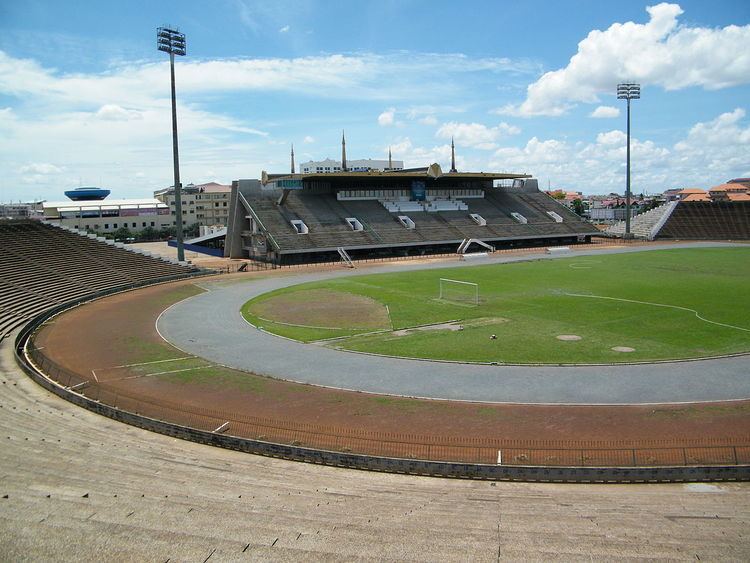Full name Olympic Stadium Broke ground 1963 Capacity 70,000 Architect Vann Molyvann | Location Phnom Penh, Cambodia Opened 1964 Phone +855 86 734 905 | |
 | ||
Address Charles de Gaulle Blvd (217), Phnom Penh 12253, Cambodia Teams Cambodia national football team Similar Independence Monument, Royal Palace - Phnom P, Wat Ounalom, Cambodia–Vietnam Friendship Monument, Tuol Sleng Genocide Museum | ||
The National Olympic Stadium (Khmer: ពហុកីឡាដ្ឋានជាតិអូឡាំពិក) is a multi-purpose stadium in Phnom Penh, Cambodia. It has a capacity of 70,000. Despite its name, the stadium has never hosted an Olympic Games.
History
Construction on the National Sports Complex started in 1963 and was completed in 1964. Designer Vann Molyvann made use of massive earthworks to create the stadium, digging up 500,000 cubic meters of earth to shape the grounds.
The stadium might have been built to host the 1963 Southeast Asian Peninsular Games, but the games were cancelled due to political problems in Cambodia. There was also the short-lived GANEFO games, that were held in Phnom Penh, Cambodia in November 25~December 6, 1966 and were named 'First Asian GANEFO'. The stadium did play host to appearances by visiting dignitaries and state occasions, and was the home of Cambodia's national athletics teams.
The stadium played a small part in the 1966 FIFA World Cup. Unexpectedly, North Korea faced Australia in a qualifier. Because North Korea lacked diplomatic relations with most countries, finding a suitable venue for the match proved difficult, until Head of State Norodom Sihanouk, an ally of Kim Il-sung, said the matches could be held in Phnom Penh. The matches attracted 40,000 fans, with Sihounouk decreeing half would cheer for Australia, while the other half cheered the Koreans. The matches were held on 21 November 1965 and on 24 November 1965 with North Korea winning both (6–1 and 3–1). Because South Korea and all African teams had withdrawn in protests against FIFA, North Korea were thus directly qualified to the final tournament, where they reached the quarter-final.
Among the facilities are Olympic-size pools for swimming and diving and an indoor volleyball court with a capacity of up to 8,000, now known as the Olympic Stadium Indoor Arena.
During the Khmer Rouge era, the stadium was used as an execution site where officials of the Khmer Republic formerly led by Lon Nol were killed.
In the decades following the Khmer Rouge era, the stadium facilities fell into disrepair. In 2000 the stadium complex was redeveloped by a Taiwanese firm, the Yuanta Group, which refurbished the stadium but also redeveloped parcels of the complex into condominiums and commercial properties.
As of 2007, the stadium has come to be a popular attraction for Phnom Penh residents, who attend daily exercise sessions, as well as football games and other activities.
In May 2007, the Irish singer Ronan Keating performed in concert in the stadium's Indoor Arena, the first concert by a major international act.
In November–December 2007, the World Organization Volleyball for Disabled held its world cup in the stadium's Indoor Arena, the first major international sporting event in Cambodia in more than 40 years. Cambodia, seeded fourth in the world, finished third.
In 2010 the stadium hosted all the football matches for the Cambodian Premier League, known for sponsorship purposes as the Metfone C-League.
The 2023 Southeast Asian Games will not be held at the Olympic Stadium, but at a new stadium under construction in another part of Phnom Penh, to be known as the Morodok Techo National Sports Complex.
